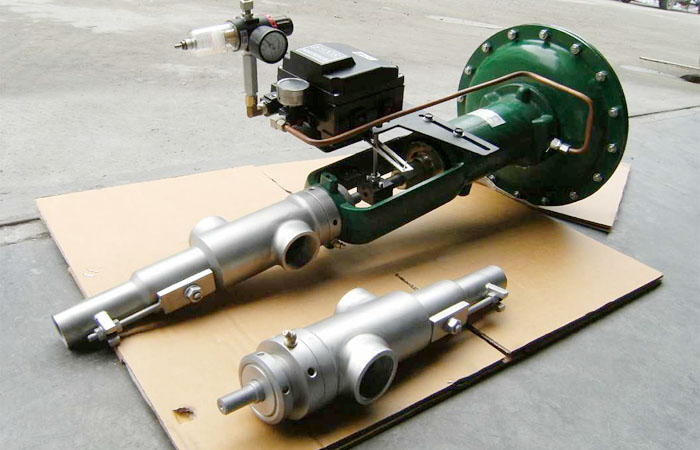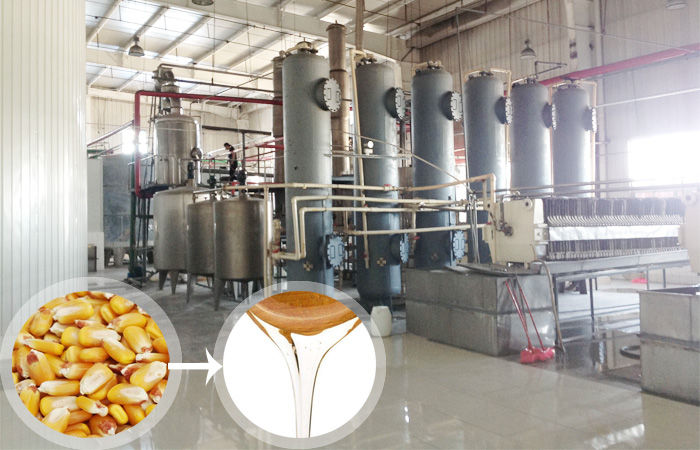1. Overview of the starch and sugar conversion process: starch mixing, liquefaction, saccharification, decolorization, ion exchange, vacuum concentration.
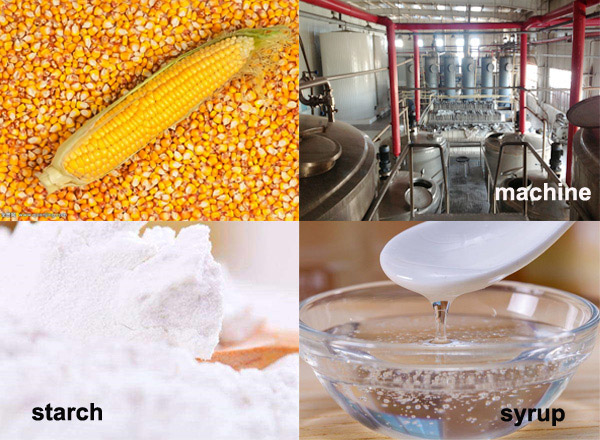 Production of starch syrup from corn starch
Production of starch syrup from corn starch
2. Starch and sugar conversion process details:
(1) Raw material requirements: Commonly used corn starch with higher purity, followed by cassava starch, potato starch and sweet potato starch.
(2) Mixing: In the mixing tank, first add some water, add the dry starch or wet starch under stirring, after the feeding is completed, continue to add water of about 80 °C, so that the concentration of starch milk reaches 22-24 Be, then added a-enzyme to adjust the pH to 1.8, soft water is needed for the mixing process to avoid the generation of more phosphate which will make the sugar liquid turbid.
(3) Saccharification: The adjusted starch milk is sent to the saccharification tank with an acid-resistant pump. The steam is opened while feeding, so that the mash is heated evenly. After being heated to the required pressure for 3 to 5 minutes, the DE value is sampled and measured in time to reach 38 to 40, then the saccharification is completed.
(4) Decolorization and filtration: the neutralized sugar liquid is cooled to 70-75 ° C, the pH value is adjusted to 4.5, and the powdered activated carbon is added to the material mass of 0.25%, and the mixture is stirred for about 5 minutes, the filtrate is filtered by a filter press or a horizontal closed drum-shaped leaf.
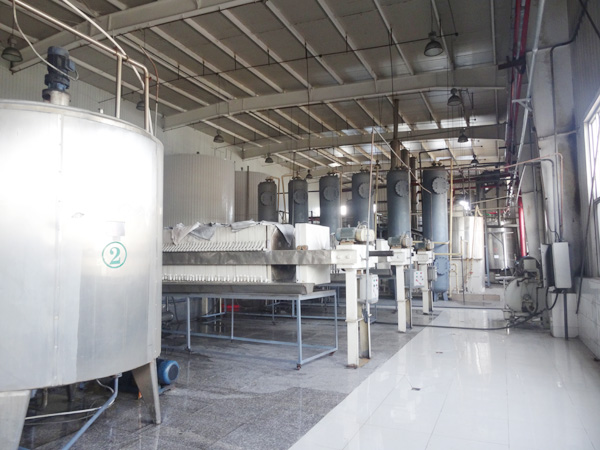 Starch sugar production equipment
Starch sugar production equipment
(5) Ion exchange: The first decolorized and filtered sugar liquid was desalted and purified by ion exchange columns.
(6) The first concentration: the pH of the purified sugar liquid is adjusted to 3.8-4.2, and is pumped into the evaporation tank to maintain a vacuum degree of 66.661 Pa or more, and the heating steam pressure does not exceed 0.98×10. Pa, concentrated to 28-31Be, then send to next process and subjected to a second decolorization.
(7) Second decolorization filtration: The second decolorization is the same as the first time. The second decolorizing syrup must be repeatedly reflux filtered until no activated carbon particles are present, and the pH is adjusted to 3.8-4.2.
(8) Second concentration: the same as the first concentration, except that sodium bisulfite is added before concentration, so that the sulfur dioxide content in the sugar liquid is 0.0015% to 0.004%, in order to bleach and protect the color, evaporate to 36-38 Be, then discharged is the finished product starch sugar.
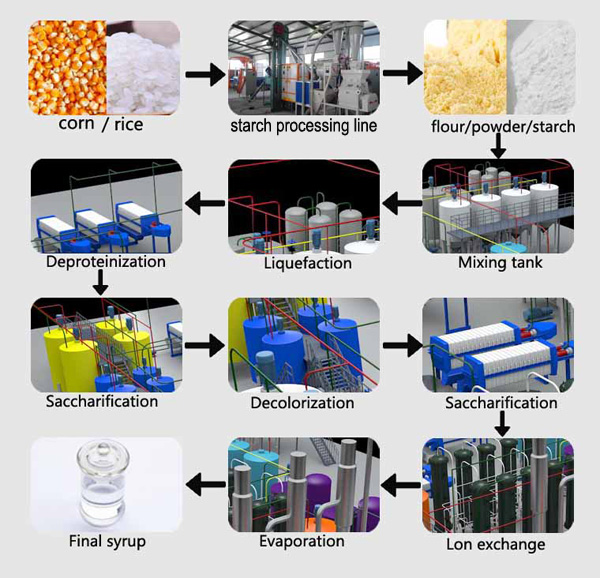 Production process for starch convert to sugar
Production process for starch convert to sugar
3. Operation points for starch and sugar conversion process:
The concentration of starch milk is controlled at about 30% (25%-30% if use rice flour), the pH value is adjusted to 6.2 with Na2C03, and the appropriate amount of CaCl2 is added to add high temperature α-starch. The enzyme is about 10 u/g (for the starch, u is the vitality unit), and the liquefaction is carried out after the slurry is evenly mixed. The temperature is generally controlled at (110±5) °C, and the liquefaction DE value is controlled at 15%-20% with iodine. The color reaction is reddish brown, the protein in the sugar liquid is well aggregated, the layering is obvious, and the filtration performance of the liquefied liquid is good as the index at the end of the liquefaction.
The saccharification operation is relatively simple in the starch and sugar conversion process. After the liquefied liquid is cooled to 55-60°C, the pH is adjusted to about 4.5, and the appropriate amount of saccharifying enzyme is added, generally 25-100 u/g (based on dry starch), and then the saccharification is carried out. When the required DE value is reached, the enzyme can be warmed up and the next purification process is carried out.
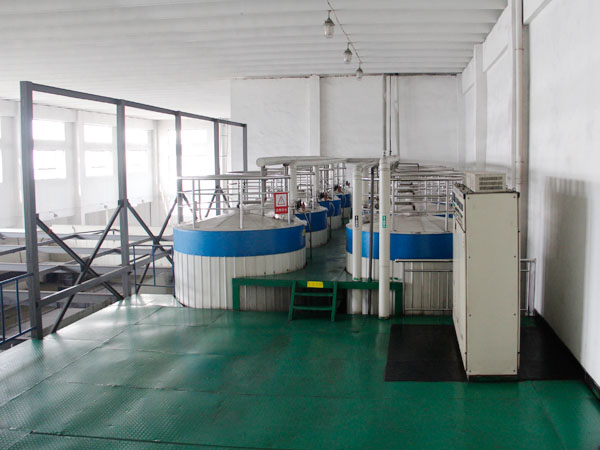 Sacharification tank
Sacharification tank
The starch saccharification solution is filtered to remove insoluble impurities to obtain a clarified sugar liquid, and further decolorization and ion exchange treatment are required to further remove water-soluble impurities in the sugar liquid.
Decolorization is generally carried out using powdered activated carbon, controlling the temperature of the sugar liquid to about 80°C, adding 1% activated carbon equivalent to the solid solution of the sugar liquid, stirring for 0.5 h, filtering with a filter press, and decolorizing the sugar liquid to 40-50°C to enter the ion exchange column to purified by cation and anion exchange resin to remove various residual impurity ions, proteins, amino acids and the like in the sugar liquid, thereby further improving the purity of the sugar liquid.
The refined saccharification solution is concentrated in vacuo to a solid content of 73%-80%, which can be used as the finished starch sugar.
Leave A Message About Starch and sugar conversion process
- Director: Ms Elina Wu
- Phone: 0086 135 2661 5783
- WhatsApp: 0086 135 2661 5783
- Tel: 0086 371 5677 1822
- sales@syrupmachine.com
- Chat Online
- The step of corn syrup extracted from corn consists mainly of two part...
- About how is corn syrup processed,in there,Doing Company will give you...
- Answer for what is starch sugar,introduce the starch sugar types,appli...
- This is the starch and sugar conversion process introduction,overview ...
- amylase and saccharification enzyme are the main enzymes involved in s...
- This is the Doing Company answer for how is corn syrup made in factory...
- This is answer for how making glucose syrup,brief glucose syrup making...
- This is Doing Company answer for what is the process of making corn st...
- Cornstarch syrup recipe introduction from Doing Company,this is the co...
- Syrup production system introduction from Doing Company,the syrup prod...
